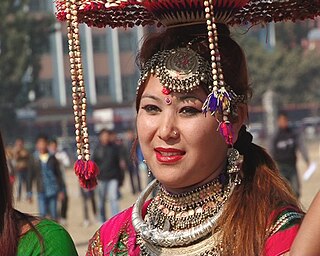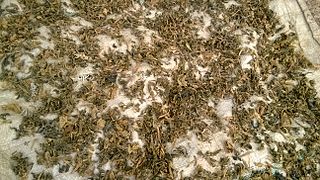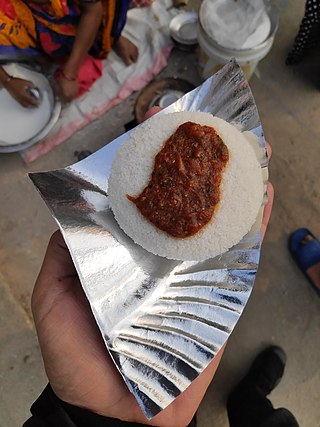Music of Nepal refers to the various musical genres played and listened to in Nepal. With more than fifty ethnic groups in Nepal, the country's music is highly diverse. Genres like Tamang Selo, Chyabrung, Dohori, Adhunik Geet, Bhajan, Filmi music, Ghazal, Classical music, songs and Ratna music are widely played and popular, but many other less common genres are yet to be cataloged. Western musical genres like Rock, Metal, Hip-Hop, Rap, R&B also regularly feature on the Nepalese music charts. Most of the country's musical bands are based in the Kathmandu valley. Musical genres from Tibet and India have greatly influenced Nepalese music.

The Tharu people are an ethnic group indigenous to the Terai in southern Nepal and northern India. They speak Tharu languages. They are recognized as an official nationality by the Government of Nepal. In the Indian Terai, they live foremost in Uttarakhand, Uttar Pradesh and Bihar. The Government of India recognizes the Tharu people as a scheduled Indian tribe.

The culture of Nepal encompasses the various cultures belonging to the 125 distinct ethnic groups present in Nepal. The culture of Nepal is expressed through music and dance; art and craft; folklore; languages and literature; philosophy and religion; festivals and celebration; foods and drinks.

Nepali cuisine comprises a variety of cuisines based upon ethnicity, alluvial soil and climate relating to cultural diversity and geography of Nepal and neighboring regions of Sikkim and Gorkhaland. Dal-bhat-tarkari is eaten throughout Nepal. Dal is a soup made of lentils and spices, bhat — usually rice but sometimes another grain — and a vegetable curry, tarkari. Condiments are usually small amounts of spicy pickle which can be fresh or fermented, mainly of dried mustard greens and radish and of which there are many varieties. Other accompaniments may be sliced lemon (nibuwa) or lime (kagati) with fresh green chilli and a fried papad and also Islamic food items like rice pudding, sewai, biryani etc. Dhindo (ढिंडो) is a traditional food of Nepal. A typical example of Nepali cuisine is the Chaurasi Byanjan set where bhat (rice) is served in a giant leaf platter (patravali) along with 84 different Nepali dishes each served on small plates. It is mostly fed during weddings and Pasni.

Gundruk is a fermented leafy green vegetable originated in Nepal. Alongside Nepal, it is also popular cuisine in Sikkim and few regions of India, Bhutan, Myanmar and other parts of the world. The annual production of gundruk in Nepal is estimated at 2,000 tons and most of the production is carried out at the household level.
Bihari cuisine is eaten mainly in the eastern Indian state of Bihar, as well as in the places where people originating from the state of Bihar have settled: Jharkhand, Eastern Uttar Pradesh, Bangladesh, Nepal, Mauritius, South Africa, Fiji, some cities of Pakistan, Guyana, Trinidad and Tobago, Suriname, Jamaica, and the Caribbean. Bihari cuisine includes Angika cuisine, Bhojpuri cuisine, Maithil cuisine and Magahi cuisine. Dal Puri

The Tharu or Tharuhat languages are any of the Indo-Aryan languages spoken by the Tharu people of the Terai region in Nepal, and neighboring regions of Uttarakhand, Uttar Pradesh and Bihar in India.

Masaura or Masyaura is a fermented sun-dried vegetable balls made with a combination of various or single minced vegetables with black lentils. It originated in Nepal and is made by Nepali diaspora throughout the world. The choice of vegetables is mostly taro, yam, and colocasia leaf. As finding fresh vegetables was a hard all-around year in the earlier days, masyaura become an alternative nutritious food item when fresh vegetables weren't available. It is fried in oil and made into a curry.

Jitiya is a three-day-long Ancient Hindu festival which is celebrated from the seventh to ninth lunar day of Krishna-Paksha in Ashvin month. It is celebrated mainly in Nepal and the Indian states of Uttar Pradesh, Bihar and Jharkhand. Mothers fast for well-being of their sons. It is celebrated for eight days in Jharkhand from first moon day to eight moon day in the first half of Ashvin month.

Angika is an Eastern Indo-Aryan language spoken in some parts of the Indian states of Bihar and Jharkhand, as well as in parts of Nepal.

Dhindo is a meal prepared in Nepal. It is prepared by gradually adding flour to boiling water while stirring. It is a staple meal in various parts of Nepal, specially Tamangs in the Hilly Region of Nepal and the Sikkim and Darjeeling regions of India. Though it is a staple food in Nepal, dhindo has previously been seen as an inferior food compared to rice, and was associated with low status. The inclusion of dhindo on urban restaurant menus has coincided with a rise in the food's prestige, possibly attributable to the changing perception of Nepal's indigenous crops, which are now recognized for their nutritional advantage.

Madhesh Province is a province of Nepal in the Terai region with an area of 9,661 km2 (3,730 sq mi) covering about 6.5% of the country's total area. It has a population of 6,126,288 as per the 2021 Nepal census, making it Nepal's most densely populated province and the smallest province by area. It borders Koshi Pradesh to the east and the north, Bagmati Province to the north, and India’s Bihar state to the south and the west. The border between Chitwan National Park and Parsa National Park acts as the provincial boundary in the west, and the Kosi River forms the provincial border in the east. The province includes eight districts, from Parsa in the west to Saptari in the east.

Medu vada is a South Indian breakfast snack made from Vigna mungo. It is usually made in a doughnut shape, with a crispy exterior and soft interior. A popular food item in South Indian cuisine it is generally eaten as a breakfast or a snack.

Maithil cuisine, also known as Mithila cuisine, is a part of Indian and Nepalese cuisine. It is the traditional cooking style of Maithils residing in the Mithila region of the subcontinent.

Aloo tama or aloo bodi tama is a Nepali soup dish made of fermented bamboo shoots, potatoes and black-eyed peas.

Dhikri is a Nepalese steamed rice cake primarily prepared by the Tharu people and Madheshi people of southern Nepal. It is an essential food for the Maghi festival. It is also served in other festivals such as Dashain and Chhath.

Bhakkha is a traditional food of the Rajbanshi and Tharu people from West Bengal, Seemanchal and South eastern Nepal. It is a fluffy rice cake.
Toran-La is the biggest festival of Thakali people of Nepal. It falls on the same day as Holi and generally lies in the month of March. The festival lasts for three days- before, after and the night of full moon.

Ghonghi is a Nepalese fresh water snail dish prepared by the Madheshi and Tharu people of southern Nepal. It is eaten by sucking the snail from its shell and is found throughout the Madhesh Province and Terai districts of other states. It is also popular among Rajbanshi, Dhimals, Santhal and Danuwar people of Terai.
















